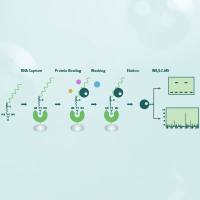Small guanosine 5′-triphosphatases (GTPases) of the Ras superfamily switch between a guanosine 5′-diphosphate (GDP)-bound and a guanosine 5′-triphosphate (GTP)-bound conformation. This cycle is regulated by guanine nucleotide exchange factors that release the bound nucleotide. Since the concentration of GTP is about 10-fold higher than GDP, the empty binding site is rapidly filled with predominantly GTP. The conversion of GTP to GDP is facilitated by GTPase-activating proteins (GAPs), which contribute an extra catalytic group to the intrinsic GTPase activity of the proteins. In general, the GTP-bound form is the active form of the protein, and measurements of the ratio of GDP-GTP bound determines the activation state. Until recently the common method to measure the active GTP-bound form of small GTPases was immunoprecipitation of 32P- labeled protein followed by separation of the bound, radiolabeled GDP and GTP by thin-layer chromatography. This method allows determination of the percentage of GTP bound. This method still is the “gold standard,” but it is technically demanding and needs relatively high levels of radioactivity. Furthermore, side effects owing to radiation-induced DNA damage cannot be excluded. For a large number of small GTPases, an additional and more serious problem is that suitable precipitating antisera are still unavailable. This implies that epitope-tagged GTPases have to be used to assess activation.






